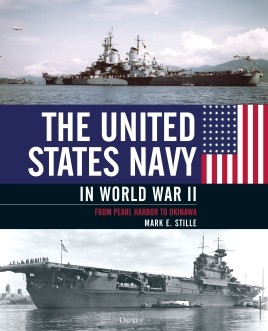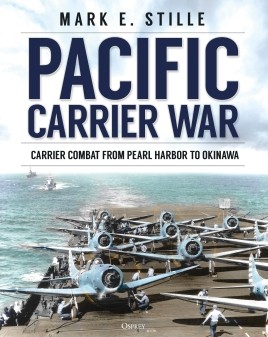On the blog today, Mark Stille, author of The United States Navy in WWII and Pacific Carrier War, takes us through the damage inflicted on the US Navy at Pearl Harbour to commemorate the 80th anniversary of the attack.
 |
 |
Without doubt, one of the most important events of World War II was the Japanese attack on Pearl Harbor. This bold operation was the result of the unceasing efforts of one man – Admiral Yamamoto Isoruku, commander of the Imperial Japanese Navy’s (IJN) Combined Fleet. Against almost universal opposition within the IJN, Yamamoto’s energy and determination, added to his threat to resign if the operation was not approved, made the Pearl Harbor attack a reality.
Yamamoto’s chosen instrument for the attack was the Kido Butai (Striking Force) under the command of Vice Admiral Nagumo Chuichi. The Kido Butai comprised the IJN’s six fleet carriers, making it the most powerful naval force in the world in December 1941. Nagumo had serious doubts about his prospects for success. He thought that problems with refueling the strike force on the way to Hawaii and the unlikelihood of gaining surprise made the plan’s success nearly impossible. There were other operational details that had to be resolved before the planned attack became viable. Commander Genda Minoru, the Kido Butai’s air operations officer, was the leading planner for the attack and became, alongside Yamamoto, the most important man in the plan’s implementation.
The final attack plan devised by Genda called for two attack waves. In the first wave, the battleships and carriers moored around Ford Island were slated for destruction by a combination of 40 torpedo and 50 level bombers. Dive-bombers were used to attack bases at Ford Island, Hickam Field and Kaneohe to cripple American air power. The second wave would arrive shortly after the first so that the Americans would have little time to recover. This strike included 54 level bombers to complete the destruction of American air power. The heart of the second wave were the 78 elite dive-bombers ordered to attack naval targets.
On November 22, ships of the attack force departed their homeports individually or in pairs, bound for Hitokappu Bay in the Kuriles. On November 24, the attack force departed the Kuriles for Pearl Harbor. Transit to the launch point 230nm north of Oahu took 13 days. During the long transit through the rough waters of the North Pacific Ocean, the Japanese encountered no ships. Diplomatic efforts having failed, the message “Climb Mount Niitaka 1208” was received on December 2. This confirmed the attack would begin as scheduled on the morning of December 7. At 1130hrs on December 7, the Kido Butai changed course to 180 degrees and headed straight for Hawaii.
Beginning at 0530hrs on the morning of December 7, the first wave was spotted on the flight decks of the six Japanese carriers and aircraft engines began warming up. The Kido Butai increased speed to 24 knots to get sufficient wind across the deck for take-off. The first wave began taking off at 0600hrs. All aircraft were off the decks within an impressive 15 minutes. Following take-off the 183 aircraft of the first wave formed a single loose formation and headed south. Immediately after the launch of the first wave, preparations began for launching the second. The same procedure was repeated with the aircraft quickly spotted on the flight decks and their engines warmed. The fleet again turned into the wind for a second launch at 0705hrs and ten minutes later the aircraft began to lift off. The second wave of 167 aircraft headed south to Oahu.
Despite being picked up by three of the five operational American radars on the island, the Japanese retained surprise when only one of these stations reported its contact; the report was quickly dismissed by the Air Defense Center at Fort Shafter.
The attack by the 40 torpedo bombers was the most important part of the Japanese plan. Of the eight American battleships present, five were vulnerable to torpedo attack. Confident they had addressed the problem of employing torpedoes in the shallow harbor, Japanese planners expected that 27 of the 40 torpedoes would hit a target. The torpedo attack opened with 16 torpedo bombers from Soryu and Hiryu headed for the usual mooring locations of the American carriers. On this morning, no carriers were present, forcing the Japanese pilots into a series of split-second decisions as to which targets to attack. The result was chaos, which resulted in the expenditure of precious torpedoes against secondary targets. Two torpedoes hit the training ship (and former battleship) Utah, which rolled over and sank. Another hit the old light cruiser Raleigh and caused severe flooding. One pilot decided on a large target along the 1010 Pier in the Navy Yard. This was the ancient minelayer Oglala moored outboard of the modern light cruiser Helena. This torpedo ran under Oglala and hit Helena, where it flooded one boiler room and one engine room. The explosion split open Oglala’s hull and she sank two hours later.
The 12 torpedo bombers from Akagi led the attack against Battleship Row. Genda’s plan had these aircraft approach in a line-ahead formation from the same point. Battleships Oklahoma and West Virginia were directly in front of the approaching Japanese aircraft and took the brunt of the attack. Kaga’s 12 torpedo aircraft were the last to attack. By this time the Americans had increased the volume of antiaircraft fire and the flawed Japanese approach exposed each aircraft in sequence to antiaircraft fire. As a result five of the 12 Kaga torpedo bombers were shot down, making them the only torpedo aircraft lost. Despite the confusion and the overconcentration on Oklahoma and West Virginia, Japanese torpedoes wreaked havoc. In just 11 minutes, and for a cost of only five aircraft (and a sixth later forced to ditch), the torpedo bombers sank two battleships and inflicted damage leading to the sinking of two more. Added to this was the sinking of a target ship and a minelayer, and damage to two light cruisers. Of the 36 torpedoes launched, it is likely that 19 hit.
The second fist of the Japanese double-punch against Battleship Row was comprised of level bombers carrying armor-piercing 1,760lb bombs. Forty-nine aircraft approached Battleship Row from the south at 10,000 feet in groups of five. The primary targets were the battleships moored inboard. Maryland was moored inboard from Oklahoma; of all the battleships on Battleship Row, she was the least damaged. Maryland was hit by a bomb on the forecastle below the waterline. A second hit the forecastle but caused little damage. Tennessee,moored inboard of West Virginia, also suffered little damage during the attack. Moored just aft of Tennessee was Arizona with repair ship Vestal alongside. Arizona took two hits. The first hit aft on the quarterdeck, and the second struck forward, penetrating the forward 14-inch gun magazine, which resulted in a cataclysmic explosion. The explosion killed 1,177 crewmen and completely destroyed the forward part of the ship. The destruction of Arizona has become the iconic moment of the entire attack and has overshadowed the overall poor results from the level bombers. The best assessment is that ten hits were scored out of 49 bombs dropped; however, of the ten hits, six failed to explode or resulted in low-order detonations.
The first of the 167 aircraft of the second wave arrived over their targets approximately 25 minutes after the last aircraft of the first wave had departed. The centerpiece of the second wave was the 78 dive-bombers. Against stationary ships in Pearl Harbor, the Japanese expected impressive results. Since there were no carriers present, and the 550lb bombs carried by the dive-bombers were unsuited for attacking heavily armored battleships, the prioritization plan called for attacking cruisers. However, only 17 dive-bombers attacked cruisers, while some 30 selected battleships, as many as 16 attacked destroyers, and 12 attacked auxiliaries. Using American after-action reports, it remains difficult to account for the attacks of all 78 dive-bombers. However, it is clear that the dive-bomber attack was unfocused and failed to live up to Japanese expectations.
The results of the dive-bomber attack were extremely disappointing for the Japanese. They claimed 49 hits, but the actual number was probably 15. American antiaircraft fire was fairly heavy during this point in the battle, which resulted in the loss of 14 dive-bombers. An accuracy rate of under 20% against stationary targets is hard to explain. There was considerable smoke in the harbor area, but the best explanation was the 70–90% low overcast over the harbor during the attack. In addition to their poor accuracy, the dive-bomber pilots were also guilty of poor target selection and grossly exaggerated battle damage assessment reports.
First and second wave aircraft hit the various airfields located around the island. Zuikaku’s dive-bombers attacked Wheeler Field, where some 120 fighters were parked in neat rows. Thirty-three PBY patrol aircraft were present at Kaneohe Naval Air Station. Between Shokaku and Zuikaku fighters in the first wave and 18 level bombers from Shokaku in the second, 27 of the PBYs were destroyed, with the remaining six damaged. Ewa Mooring Mast Field was the home of Marine Air Group 21 with 49 aircraft. At the end of the raid, 33 of Ewa’s aircraft were damaged or destroyed.
Ford Island Naval Air Station was home to two patrol squadrons and many other miscellaneous aircraft. After the work of Shokaku dive-bombers and level bombers, aided by Kaga fighters, 33 aircraft were lost, including 19 PBY patrol planes. Hickam Field was a key target, as it was the principal bomber base on the island. At the beginning of the attack, 12 B-17s, 32 B-18s and 12 A-20s were lined up in rows. After the work of dive-bombers, fighters, and level bombers, five B-17s, seven B-18s and two A-20s were destroyed and another 19 damaged.
Despite a persistent myth to the contrary, the Japanese never seriously considered launching a third wave. Nagumo was content to withdraw as soon as he recovered his aircraft. By 1215hrs, the last aircraft was aboard. Heavy seas made the recovery challenging, and according to one Japanese source, as many as 20 aircraft were forced to ditch or were thrown overboard as a result of unrepairable battle damage or heavy landings.
The Japanese raid on Pearl Harbor accounted for 18 American ships either sunk or damaged. Damage was concentrated on the eight battleships present. Of these, three returned to service in just weeks, one in 1943, two in 1944, and two (Arizona and Oklahoma) never returned to service. Since slow battleships were not useful in the kind of war the Pacific Fleet now faced, Yamamoto had failed to deal the Americans a knockout blow. When Yamamoto tried again to annihilate the Pacific Fleet off Midway Atoll in June, the supposedly crippled American Navy achieved a decisive victory against the Kido Butai just six months after Pearl Harbor. Strategically, the attack was a disaster for the Japanese. The attack galvanized American society and undermined any prospects of a negotiated peace.
To find out more about the US Navy's ships check out Mark Stille's recent title The United States Navy in WWII. Available here
You may aslo be interested in Pacific Carrier War, a detailed and comprehensive study of the carrier formations of the Pacific War, including their origins, development and key battles from the Coral Sea, through Midway and Guadalcanal to the battle of the Philippine Sea.

Comments
You must be logged in to comment on this post. Click here to log in.
Submit your comment